
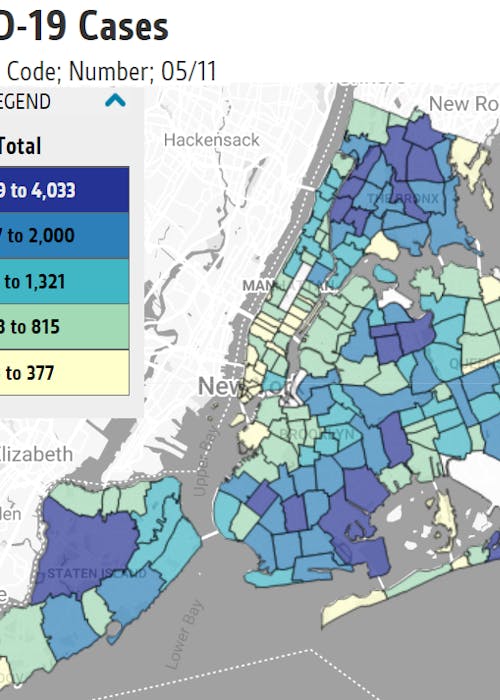
NYC Housing Affordability And Homelessness Crises Exacerbated By Covid-19
Digital Briefs
May 19, 2020
Long before the economic fallout from the COVID-19 pandemic, many New Yorkers faced severe rent burden, overcrowded living conditions, unstable employment opportunities, and other immense challenges to their housing security. For years, rising rents outpaced wage growth, and now an estimated 475,000 New Yorkers may lose their jobs over the coming year, which will exacerbate housing instability in New York City.
Working with its partners in the Family Homelessness Coalition (FHC), CCC is focused on advancing policy priorities to prevent homelessness, improve conditions in homeless shelters, and expand access to affordable housing. These priorities are even more critical today as we move towards a citywide recovery plan. Below, CCC highlights existing data that point to the alarming and disproportionate impact that COVID-19 has on communities that were already grappling with housing instability
Disparate Impacts Of COVID-19 On Communities Of Color
Tragically, data from the NYC Department of Health show that many NYC communities reporting higher numbers of positive COVID-19 cases are also those which have been in need of greater investments to address housing insecurity long before the current crisis. Residents in many of these hardest hit communities are predominantly Black and Latino, and to address housing insecurity in NYC requires that we confront racism and discrimination.
COVID-19 Cased by ZIP Code
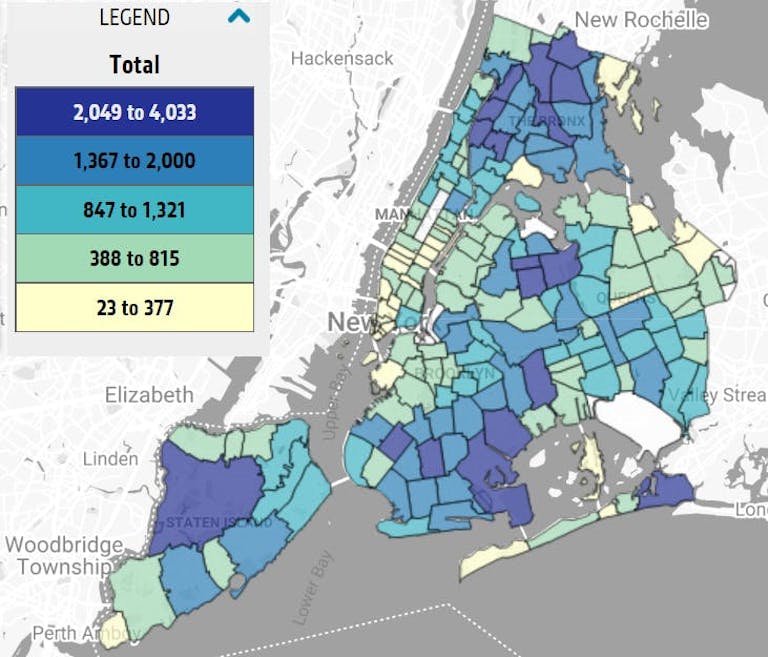
SHARE OF BLACK AND LATINO RESIDENTS BY COMMUNITY DISTRICT, 2018
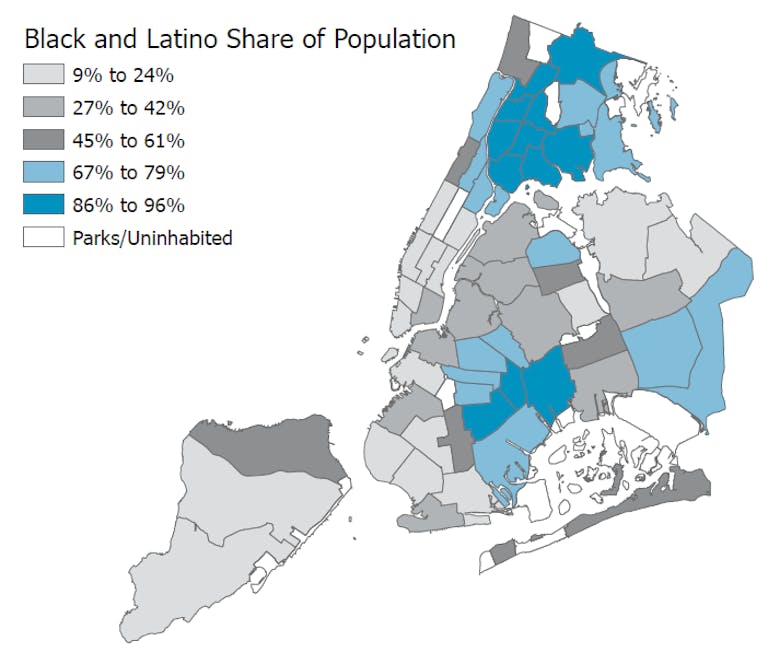
Just prior to the COVID-19 pandemic, the city had released Where We Live NYC, a draft plan detailing goals, strategies, and actions the City of New York will undertake to advance fair housing over the next five years. The process to develop the plan included efforts to better understand how challenges like segregation and discrimination impact New Yorker’s everyday lives. CCC provided public comment on the draft plan, which focused on ensuring families with children in shelter, and those at risk of homelessness, are at the forefront of the City’s efforts. These families are two-thirds of the shelter population, and disproportionally Black and Latino.
THREE KEY INDICATORS OF HOUSING INSECURITY TO MONITOR
The crisis has put a spotlight on the conditions that we have known compromise the well-being of children and families. In CCC’s recent report, Child and Family Well-being in NYC, we examine the combination of 18 indicators across six domains of well-being: economic security, housing, health, education, youth, and family and community. The Housing Domain comprises three key indicators measuring housing security at the community-level:
- Families with Children in Homeless Shelters, which identifies the population adjusted rates for each community district where families lived prior to shelter
- Rental Overcrowding, which identifies the share of households in each community district where there is more than one person per room living in rental housing units
- Severe Rent Burden, which identifies the share of households in each community district spending more than half of their monthly income on rent
As shown in the map below for the Housing Domain of CCC’s Child and Family Well-being Index, risks to the housing security of NYC families are greatest in several Bronx communities, as well as Borough Park, Brooklyn. Each of these are ranked in the Highest Risk category (red). Risks to housing security are also higher in East New York and Brownsville in Brooklyn, as well as Elmhurst/ Corona, Jackson Heights, and Jamaica in Queens, and the North Shore of Staten Island. These communities are ranked in either the Moderate High Risk (orange) or Moderate Risk (yellow) categories in the index based on the three indicators of rate of family homelessness, rental overcrowding, and severe rent burden in these districts. Several of these districts are also communities with high numbers of positive COVID-19 cases.
COVID-19 Cases by ZIP Code
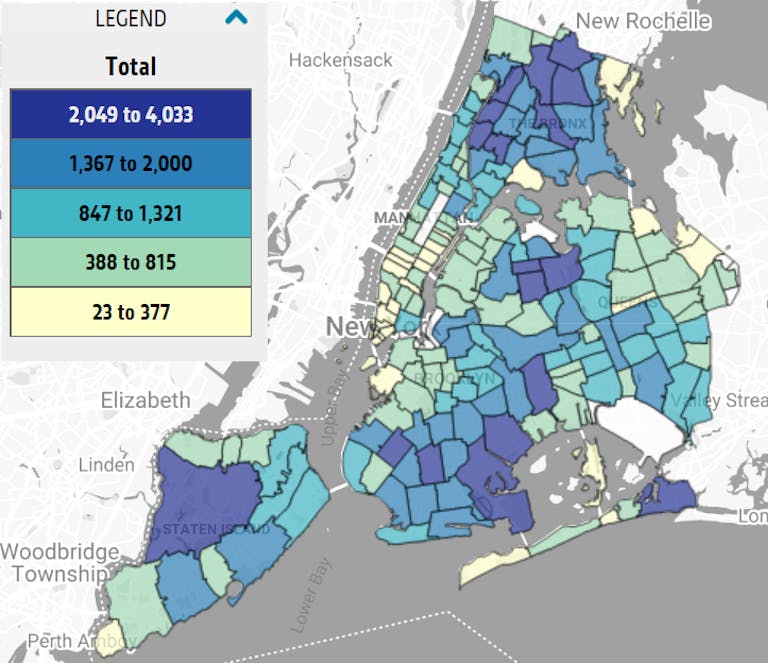
HOUSING DOMAIN OF THE CHILD AND FAMILY WELL-BEING INDEX

Families With Children In Shelter
Several communities with the highest rates of families in shelter, specifically, are also those with higher shares of COVID 19 cases, including East Tremont in the Bronx and East New York in Brooklyn.
COVID-19 Cases by ZIP code

FAMILIES WITH CHILDREN IN SHELTER (RATE PER 1,000 HOUSEHOLDS), FY 2018
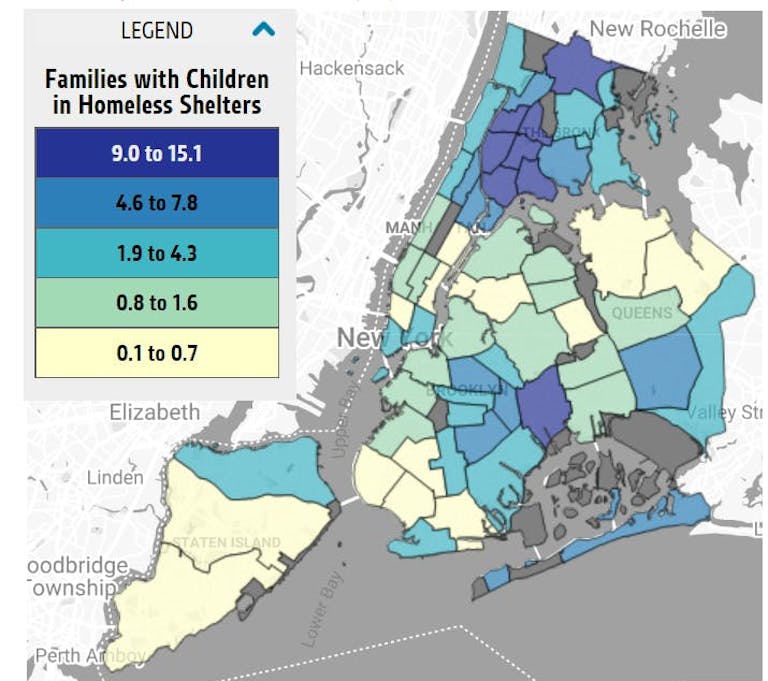
RE-ENTRIES AMONG FAMILIES WITH CHILDREN INTO DHS SHELTER, BY EXIT WITH/WITHOUT SUBSIDIES

While re-entries to shelter among families with children have declined in recent years, more than one in five families with children who exit homeless shelters without a housing subsidy return to shelter within 12 months.
Overcrowded Housing Conditions
Overcrowded housing conditions also increase risk of exposure to the virus, and several communities where high rates of positive COVID-19 cases occur also have higher rates of overcrowded rental housing. This is particularly true in Jackson Heights and Elmhurst/Corona in Queens, as well as Borough Park in Brooklyn.
COVID-19 CASES BY ZIP CODE

SHARE OF RENTAL UNITS THAT ARE OVERCROWDED
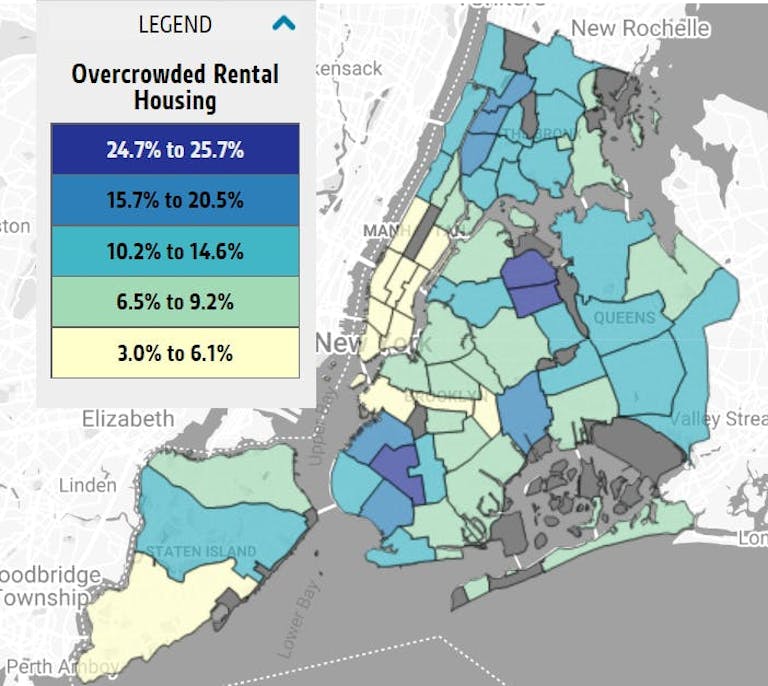
More distressing is when looking at households with children, the overcrowding rates in these communities is much higher. About half of households with children are overcrowded in multiple communities.
Overcrowded Rental Housing by Household Type, 2018
Severe Rent Burden
In addition to the risks around overcrowded rental housing, the burden of housing affordability is also prevalent in several hard-hit communities, such as East Tremont in the Bronx and Borough Park in Brooklyn. More than one in three households in these areas pay more than half their income towards rent.
COVID-19 CASES BY ZIP CODE

SHARE OF HOUSEHOLDS EXPERIENCING SEVERE RENT BURDEN
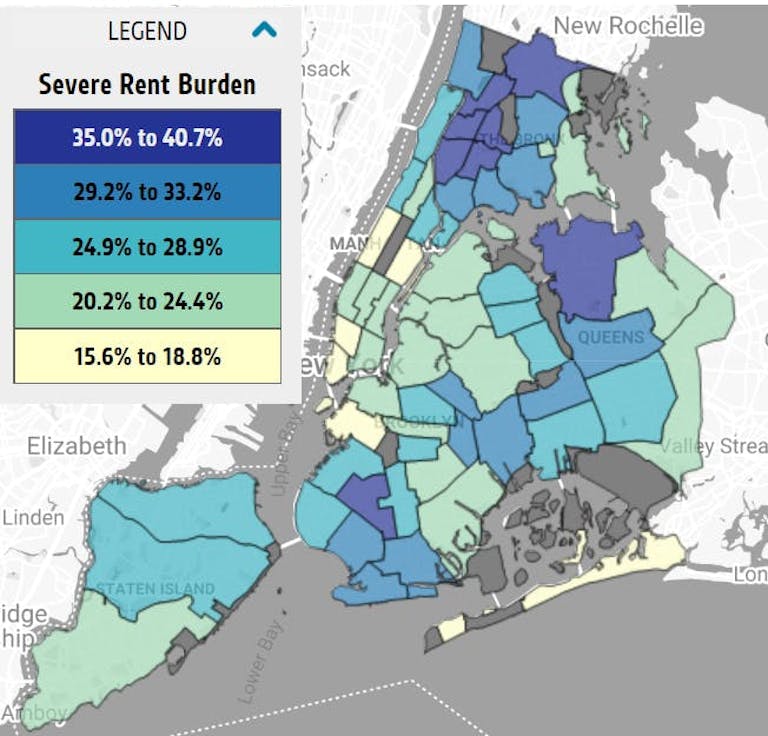
The housing affordability crisis has been a topic of policy advocacy for the decade since the Great Recession in 2008 when the trends in median rent and median household income became to shift significantly. Relative to 2005, changes in household income dipped in years after the recession and only more recently began to increase. Meanwhile, median rents grew steadily.
CHANGES IN MEDIAN RENT AND HOUSEHOLD INCOME
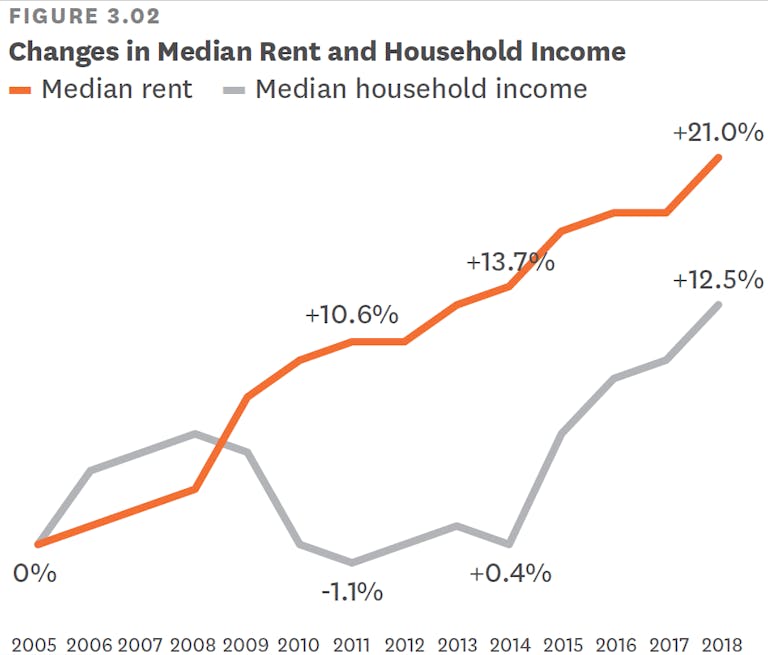
The results of this trend are an increase in the share of households that are rent burdened. Low income households are much more likely to be severely rent burdened, meaning any loss of income for these households as a result of the economic fallout related to the COVID-19 pandemic puts them on the precipice of homelessness
SEVERE RENT BURDEN BY HOUSEHOLD INCOME LEVEL, 2018
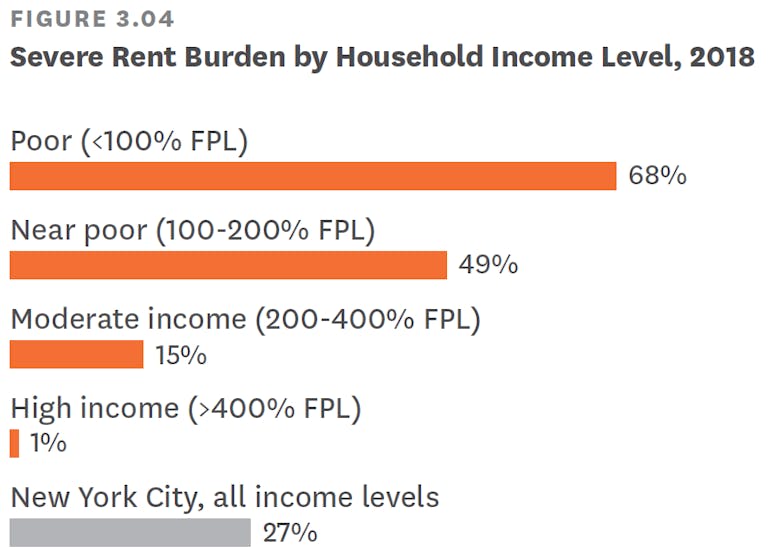
Housing Support Services – Home Base And Free Legal Services
Housing support services, such as Homebase—NYC’s homelessness prevention program—support households experiencing housing instability. During the current crisis, all Homebase locations are closed and services are available by phone to help prevent the spread of COVID-19. The same is true for HRA locations offering free legal services, which includes the Universal Access to Council program detailed below.
Even with a moratorium on evictions in place until August 2020, phone consultations these programs provide are critical to address the variety of challenges related to housing families may continue to face over the coming months. The physical location of Homebase and HRA Free Legal services locations may be less important now, but we see from the map below that these locations were not present in multiple areas of the city where indicators of housing insecurity are high. These include but are not limited to Jackson Heights and Elmhurst/Corona in Queens, and Borough Park in Brooklyn. This example from the data spotlights how investment in housing support services was already needed prior to the current crisis.
HOUSING SUPPORT SERVICES
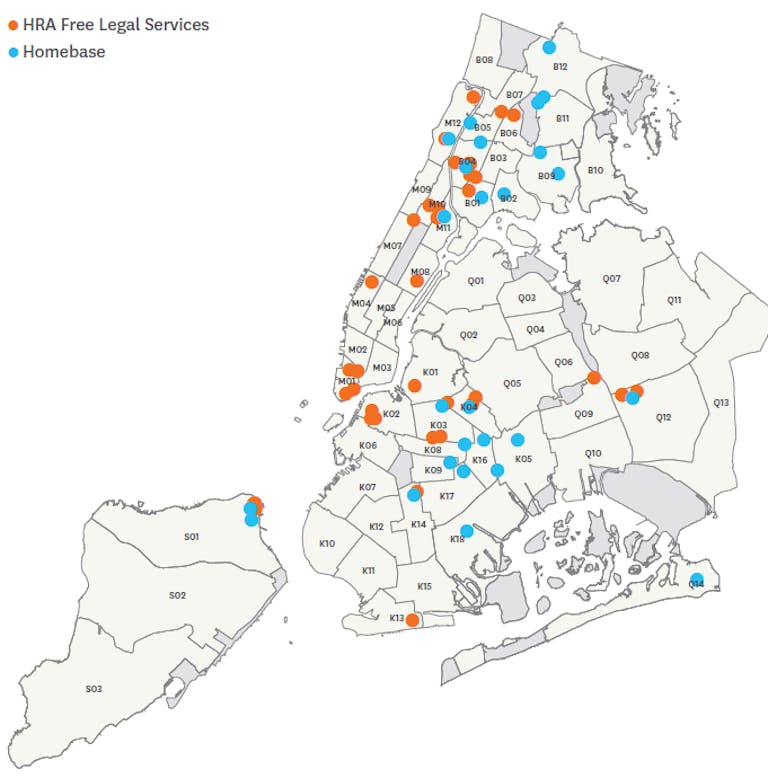
Policy Considerations
On March 20, 2020 the State of New York put a 90-day eviction moratorium in place, protecting housing for hundreds of thousands of New Yorkers. On May 7th, 2020, Governor Andrew Cuomo extended the moratorium on evictions to August 20th, 2020. Without the continuation of such protections, access to legal counsel to combat unlawful evictions will be critical, such as the Universal Access to Council program. The program provides low-income residents in targeted zip codes of the city legal representation in housing court, with plans to expand the program to all ZIP Codes in the future. Even prior to the current crisis, many advocates lauded the program and how it inspired similar efforts in other parts of the country. However, funding for the Universal Access to Council program has been cut in the City’s Executive Budget for Fiscal Year 2021. The program will be more important than ever when the moratorium on evictions is lifted. The potential surge in homelessness created by the economic fallout of the pandemic requires that the state and city place greater importance on upstream homelessness prevention programs and housing supports to both prevent shelter entry and expedite exits out of shelter and into permanent housing.
As a co-lead convener of The Family Homelessness Coalition (FHC), CCC continues to elevate family homelessness to advance policy reforms. The data illustrated above point to the disproportionate impact that COVID-19 is having on NYC communities of color that were already enduring housing instability. To prevent a surge in family homelessness in the aftermath of this pandemic, policy solutions aimed at investing in upstream homelessness prevention; improving family shelter conditions; expediting exits to permanent housing and supporting nonprofits including frontline staff are necessary. With Coalition partners, CCC continues to advance policy priorities to ensure housing security and prevent homelessness post the eviction moratorium. As noted above, households with low income are much more likely to be severely rent burdened, and the alarming numbers of unemployment insurance claims point to the magnitude of income loss across NYC households and potential inability to cover rent payments. To mitigate this increased risk to housing stability, short and long-term rent assistance will be necessary to help families recover.
Additionally, greater investments are needed to expand homelessness prevention particularly in hardest hit communities. Access to preventive services and supports further upstream – before a housing and/or eviction crisis ensues – will be key. FHC has long promoted upstream prevention models that include family supports through service coordination and case management, eviction prevention, and service referrals for childcare, education, and job training and employment. Greater resources are warranted, especially now, for community-based service supports including expanded outreach to connect with households facing the greatest challenges.
Lastly, to expedite placements into permanent for families already experiencing homelessness, efforts to streamline exits out of shelter are necessary including strengthening housing subsidies, expanding access to vouchers through online processing and continued prioritization of homeless families in the City’s affordable housing capacity.





